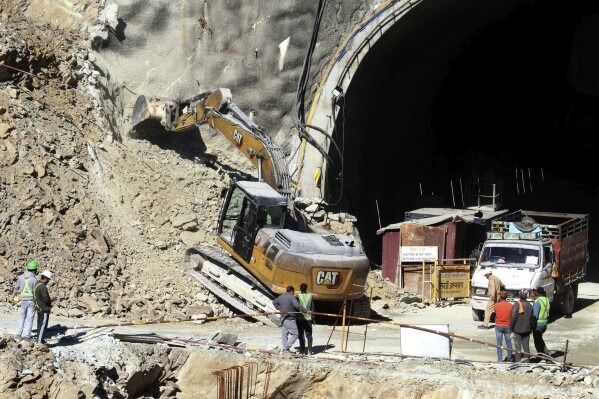The rescue operation to save 41 workers stranded in a Himalayan tunnel in India is facing unexpected delays. Initially hopeful that a heavy drill would expedite the process, officials now reveal that manual drilling has become the new approach due to machinery damage sustained on Friday.
The trapped construction workers, hailing from some of India’s economically disadvantaged states, have been confined in the 4.5-km tunnel in Uttarakhand since its collapse on November 12. While authorities assured their safety with provisions of light, oxygen, food, water, and medicines, the rescue endeavor hit a setback when the heavy drill, tasked with breaking through nearly 60 meters of debris, suffered damage. Officials confirm that the last stretch, spanning 10-15 meters, will now require the use of hand-held power tools.
Pushkar Singh Dhami, Chief Minister of Uttarakhand, announced on Saturday that the damaged drilling machine is set to be removed by Sunday morning, paving the way for the commencement of manual drilling. However, Syed Ata Hasnain from the National Disaster Management Authority cautioned that the operation is evolving into a more complex scenario, indicating a potential slowdown compared to the earlier deployment of the auger.
The psychological well-being of the trapped workers is also a growing concern. Hasnain emphasized the need to monitor their mental state, acknowledging the possibility of the operation extending over a considerable period without providing a specific timeline.
Saturday morning brought heightened anxiety among the trapped workers, all of whom are migrants. Sunita Hembrom, a relative of one of the workers, expressed concern over her brother-in-law’s well-being, stating that he hadn’t eaten since the previous day.
The cause of the tunnel collapse remains undisclosed by authorities, but the region’s susceptibility to landslides, earthquakes, and floods is well-documented. Notably, the tunnel lacks an emergency exit and was constructed through a geological fault, as revealed by an anonymous member of the expert panel investigating the incident.
The intricate rescue plan involves inserting a wide pipe to facilitate the evacuation of the trapped individuals on wheeled stretchers. A rehearsal of this process, documented in a video clip provided by authorities, demonstrated rescue workers entering the pipe and being pulled out on stretchers. Additionally, a secondary plan to drill vertically from atop the hill is in progress, with drilling machines being assembled.
Ensuring the well-being of the trapped workers, they have been receiving cooked food since a larger lifeline pipe was installed earlier in the week. More than a dozen doctors, including psychiatrists, are on-site to monitor the workers’ health and provide support. Recommendations include light yoga exercises, limited movement within their 2-km confined space, and encouraging communication among themselves. Plans to send in playing cards and board games are also under consideration.
This tunnel collapse occurred on the Char Dham pilgrimage route, a key project of Prime Minister Narendra Modi’s government aiming to link four important Hindu pilgrimage sites with a 550-mile two-lane road, at a cost of $1.5 billion.


